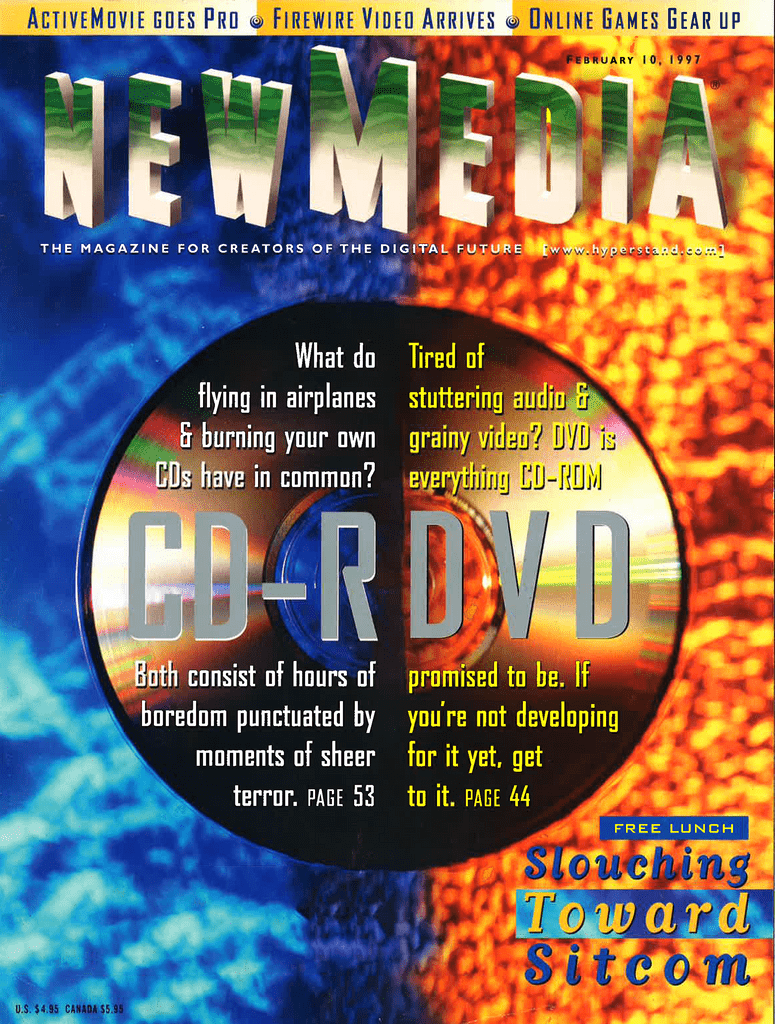
When I moved to Northfield nearly five years ago, I remember a native Minnesotan saying that if Minnesotans didn’t have the weather to talk about, they wouldn’t have anything to say. Recently, I caught myself comparing notes with (many!) colleagues about the cold and the wind and options for headwear, and realized that I’m becoming a Minnesotan. It’s a nice feeling.
What hasn’t changed is my sense that we can’t get too comfortable with our view of technology — what it is and how we use it. In other words, technology is always changing. We all know that, but it’s good to be reminded of that in depth now and then.
The Promise of the DVD (in 1997)

I got a reminder of these changes on a recent weekend at home (where it’s warm). I was going through some old boxes, and found a “tech history” folder. The cover of New Media magazine from February 10th, 1997 had a picture of a DVD with text across it that said: “DVD is everything that CD-ROM promised to be. If you’re not developing for it yet, get to it.” So 21 years ago — the year some of our students were born — the DVD was worthy of a magazine cover. I had forgotten that. At the time, it was revolutionary to be able to easily access material on a particular track using an index to jump you directly to the right spot. There was technical work to create this and end-user training to know how to use it and how to leverage this innovation. Now, after years of being an essential technology, DVDs are mostly obsolete, replaced by media streaming and cloud-hosted storage.
As I mentioned in our last issue, the Fall Educause conference (the national organization for higher ed IT professionals) had sessions about emerging technologies like virtual and augmented reality which will lead to simulations that aid student visualization of complex topics. In 20 years, will those techniques seem as old-fashioned as DVDs do now?
Top 10 Tech Issues (in 2018)
Educause recently released its annual “Top 10 Issues” report. It summarizes the key trends and issues that “keep CIOs up at night.” Number 1 on their list is information security. The University of Pennsylvania reported a few years back that new servers start seeing breach attacks in less than 15 minutes. The Equifax breach of 2017 was caused by a server that was behind on its patching. And any email link runs the risk of being a phishing or malware attack in disguise. There are many points of failure and campus-wide diligence is required. Carleton’s approach includes using Duo two-factor authentication.
The top 10 also included the issues of student success (#2), institution-wide IT strategy (#3), data-enabled institutional culture (#4) and digital integrations (#8). Carleton’s enterprise software environment is foundational in these areas and is currently under review with an outside consultant.
Change leadership (#10) is very much part of the work of the Reimagining Email, Calendaring and Storage (RECS) project, which will be wrapping up March 30th. The Web2020 project, which is moving us from a home-grown Reason environment to WordPress, is another example.
Educause has also created a whole separate list of 15 key issues in teaching and learning. It is topped by “Academic Transformation”, which they describe as breakthrough teaching and learning models and innovative partnerships. Academic Technology has created a blog which is rich with efforts in this area.
Preparing for the future
As the world steadily evolves, my top two issues for all of us would be managing the rate of technology change and the resulting need to continuously learn new skills. I’ve been impressed that Carleton community members have engaged so successfully with the move of email and storage services to the cloud. Perhaps I should expect nothing less from folks resilient enough to survive the MN winters.